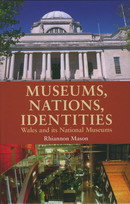review by Ian McShane

2007 marked the centenary of the granting of charters for the Welsh national museum and national library. It also marked a decade since the referendum in which a slim majority of Welsh voters supported political devolution within the United Kingdom. These events frame Rhiannon Mason's excellent study of the relationship between museums, nations and identities, with particular reference to Wales.
The establishment of the major Welsh cultural institutions at the beginning of the twentieth century locates them within a tradition of liberal governance and signals the reliance of Victorian-era reformers on the meliorative and instrumental effects of culture. Without discounting the complexity of libraries' civic and educational roles, it can be argued that the didactic and interpretive stance of museums gives them a particular status as mediators and authorisers of public conversations about culture. In focusing on Amgueddfa Cymru — National Museum Wales (NMW), Mason convincingly argues that national museums are preoccupied with questions of cultural and national identity. However, the uncertain location of Wales as a 'stateless nation' within a British imperial framework, the dynamic changes to the Welsh economy and society during the twentieth century, and the diverse interpretive frameworks and development trajectories of the campuses that make up NMW, give this story both a nuanced local character and adds complexity to wider understandings of the relationship between museums and nation.
The core of the book is an analysis of four branches of NMW: the original National Museum (which was not opened until 1927), the Museum of Welsh Life, the National Art Gallery and the National Waterfront Museum. The empirical analysis is introduced and contextualised by a foregrounding of Welsh constitutional and cultural politics and a lengthy, insightful chapter on nationalism and national museums. This chapter serves as an excellent stand-alone text for readers interested in the comparative dimension of the topic. Each of the branch institutions has a remarkable history that Mason puts to work to answer the book's major questions: how are national cultures defined within national museums and why? how important is the specific type of museum collection and discipline to the process of defining and representing national cultures? how do museums negotiate their material and intellectual legacies while responding to present-day conceptualisations of 'the nation' and its national cultures?
The author draws on familiar theoretical approaches, including the work of Ernst Gellner and Benedict Anderson on political and cultural nationalism, to argue for the constructedness of nationalism and the malleability of 'Welshness'. She argues thus that museological orthodoxy prevailing for much of the twentieth century located authentic Welshness in rural Wales, despite the significance of industrial capitalism, working class and urban cultures, and Wales's long history of inward migration. Mason gives a comprehensive account of why and how the National Museum's founding mission of 'Teaching the World about Wales and Wales about the World' (a typical rhetorical position of national museums, she argues) was selectively interpreted. She also analyses the challenges presented as NMW encounters its own history in reinterpreting that objective.
Mason's work, though, goes considerably further than providing a Welsh contribution to the expanding literature on national museums. A strength of this book is its attention to the wider social and political dynamics impacting on museum-making, even (or especially) the making of national museums. National museums are, she asserts, the subject of a multi-sided dialogue between the museum, the media, governments, policy bodies and the public. 'The presence of this extended network of players and stakeholders provides an insight to the interconnectedness of different elements of the public sphere and civil society in Wales', she argues. Adding further nuance to her account is the refreshing argument that chance and happenstance may have a significant influence on institutional direction, collection development and interpretive decisions.
A major concern of the book is to examine the impact of political devolution on NMW. Did cultural devolution, or the emergence of a distinct public infrastructure supporting museums and galleries within Wales (as opposed to support from London), concur with political devolution? Is the question of national identity commanding greater attention within the national museum in post-devolution Wales? Mason answers a cautious 'yes' to both questions. While Mason shows how NMW maps its objectives onto the Welsh Assembly government priorities (literally, in its annual report), she also argues for the Museum's agency in the re-imagining of national identities, cultures, histories and memories. Museums established on nineteenth-century nationalist principles face steep challenges in globalised, culturally diverse settings, argues Mason. Should national museums seek to enlarge the context of national identity, or work with new conceptions of post-national identity? Mason suggests that NMW — especially through the themes of empire, trade and migration pursued by its most recent branch, the National Waterfront Museum, Swansea — has shown signs of engaging with a debate that is central to the terms in which the future roles and audiences of national museums are understood.
In summary, this book effectively combines detailed empirical analysis of museum development in Wales with wider discussion of museological, cultural and political theory. In this light, the book is a both a meticulous study of the institutional forces at work in Welsh museum-making, and a fine addition to an international literature on identity, nationalism and museums.
Ian McShane is a historian by training and has a background as a curator, heritage consultant and public sector manager.
